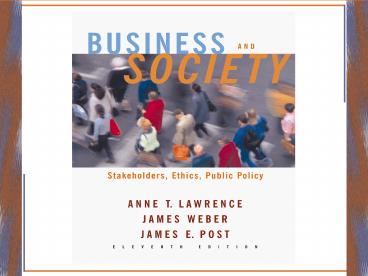Public Affairs Management - PowerPoint PPT Presentation
1 / 19
Title:
Public Affairs Management
Description:
Proxy election management. Public affairs management's relevant ... A significant business disruption that stimulates extensive news media coverage. ... – PowerPoint PPT presentation
Number of Views:283
Avg rating:3.0/5.0
Title: Public Affairs Management
1
(No Transcript)
2
Public Affairs Management
Chapter
2
- Public Issues
- Managing the Public Affairs Function
- Issue Management
- Crisis Management
3
Public issues
- Public issue
- An issue that is of concern to an organizations
stakeholders. - Stakeholder expectations
- A mixture of peoples opinions, attitudes, and
beliefs about what constitutes reasonable
business behavior. - Performance-expectations gap
- A gap between what stakeholders expect and what
an organization is actually doing.
4
Figure 2.1
A stakeholder network focusing on a public issue
Stakeholders with a shared focus on an issue
Stakeholders with a shared focus on an issue
Stakeholders with a shared focus on an issue
Stakeholders with a shared focus on an issue
Stakeholders with a shared focus on an issue
5
Phases of the public issue life cycle
- Phase 1 Changing Stakeholder Expectations
- When a performance-expectation gap emerges, the
seeds of a public issue have been sown. - Phase 2 Political Action
- When a problem is placed on the agenda for
government action. - Phase 3 Formal Government Action
- When legislative proposals or draft regulations
emerge. Characterized also by an increased
number of people involved in the conflict. - Phase 4 Legal Implementation
- When a new law or regulation is implemented and
companies are forced to comply with the law.
6
Figure 2.2
The public issue life cycle
High
Phase 1 Changing Stakeholder Expectations
Phase 2 Political Action
Phase 3 Formal Government Action
Phase 4 Legal Implementation
Level of Stakeholder Concerns
Life Cycle of Issue
Management discretion to resolve the issue
Management Discretion
Low
Time
7
Public affairs activities
- External forces
- Loss of public trust institutions
- Globalization of world markets
- Rise of the Internet
- Internal forces
- Better communication within organizations
- More experience dealing with significant change
and complexity - Growing focus on the interplay between the
organization, its environment, and its strategies - Public affairs management
- The active management of a companys external
relations, especially its relations with external
stakeholders such as government and regulatory
agencies, customers, investors, and communities.
8
Corporate public affairs activities of 250
companies
Table 2.1a
9
Table 2.1b
Corporate public affairs activities of 250
companies
10
Public affairs managements relevant stakeholders
and functions
Figure 2.3a
Public Affairs Management
- Government
- Public policy
- Lobbying
- Political action
- Trade associations
- Advocacy ads
- Grassroots mobilization
- Stockholders
- External and internal audit
- SEC filings, compliance
- Communications
- Proxy election management
11
Figure 2.3b
Public affairs managements relevant stakeholders
and functions
Public Affairs Management
- Employee
- Communications
- Union negotiations
- OSHA, EEOC, and labor law compliance
- Diversity and family-work programs
- Customers
- Customer service
- Total quality management
- Liability lawsuit defense
- Recall management
12
Figure 2.3c
Public affairs managements relevant stakeholders
and functions
Public Affairs Management
- Environment
- EPA and state environmental compliance
- Internal environmental auditing
- Recycling, take-back programs
- Community
- Corporate philanthropy
- Partners with schools, NGOs
- Volunteerism, employee time contributions
13
Figure 2.3d
Public affairs managements relevant stakeholders
and functions
Public Affairs Management
- Activists, General Public
- Environmental scanning
- Stakeholder dialogue
- Social reporting
- Social monitoring
- Media
- Public relations
- Executive speeches
- Image advertising
- Crisis management
- Web page management
14
An effective public affairs function must
- Manage public affairs as an ongoing, year-round
process. - Cultivate and harvest the capability to build,
develop, and maintain enduring stakeholder
relationships. - Influence stakeholders using refined information.
- Recognize the importance of managing the grass
roots. - Communicate in an integrated manner.
- Continuously align its values and strategy with
publics interests. - Improve its external relations using the accepted
facts of contemporary management practice.
15
Issue management
- A structured and systematic process to aid
organizations in identifying, monitoring, and
selecting public issues that warrant
organizational action. - Environmental intelligence
- The acquisition of information gained from
analyzing the multiple environments affecting
organizations. - Customer
- Competitor
- Economic
- Technological
- Social
- Political
- Legal
- Geophysical
16
Eight strategic radar screens
Figure 2.4
Customer Environment
Competitor Environment
Geophysical Environment
Seeking Environmental Intelligence
Economic Environment
Legal Environment
Technological Environment
Political Environment
Social Environment
17
Figure 2.5
The issue management process
Issues Identification
Issues Analysis
Research
Performance evaluation
Judgment and priority setting
Results
Policy Options
Program Design
Implementation
Policy and strategy selection
18
Crisis management
- Corporate crisis
- A significant business disruption that stimulates
extensive news media coverage. - Crisis management
- The process organizations use to respond to
short-term and immediate corporate crises.
19
An effect crisis management plan involves
- Preparing for action by creating an internal
communication system that can be activated the
moment the crisis occurs. - Communicating quickly, but accurately.
- Using the Internet to convey the public affairs
message. - Doing the right thing by not minimizing the
seriousness of a problem nor exaggerating minor
incidents. - Following up and, where appropriate, making
amends to those affected.































